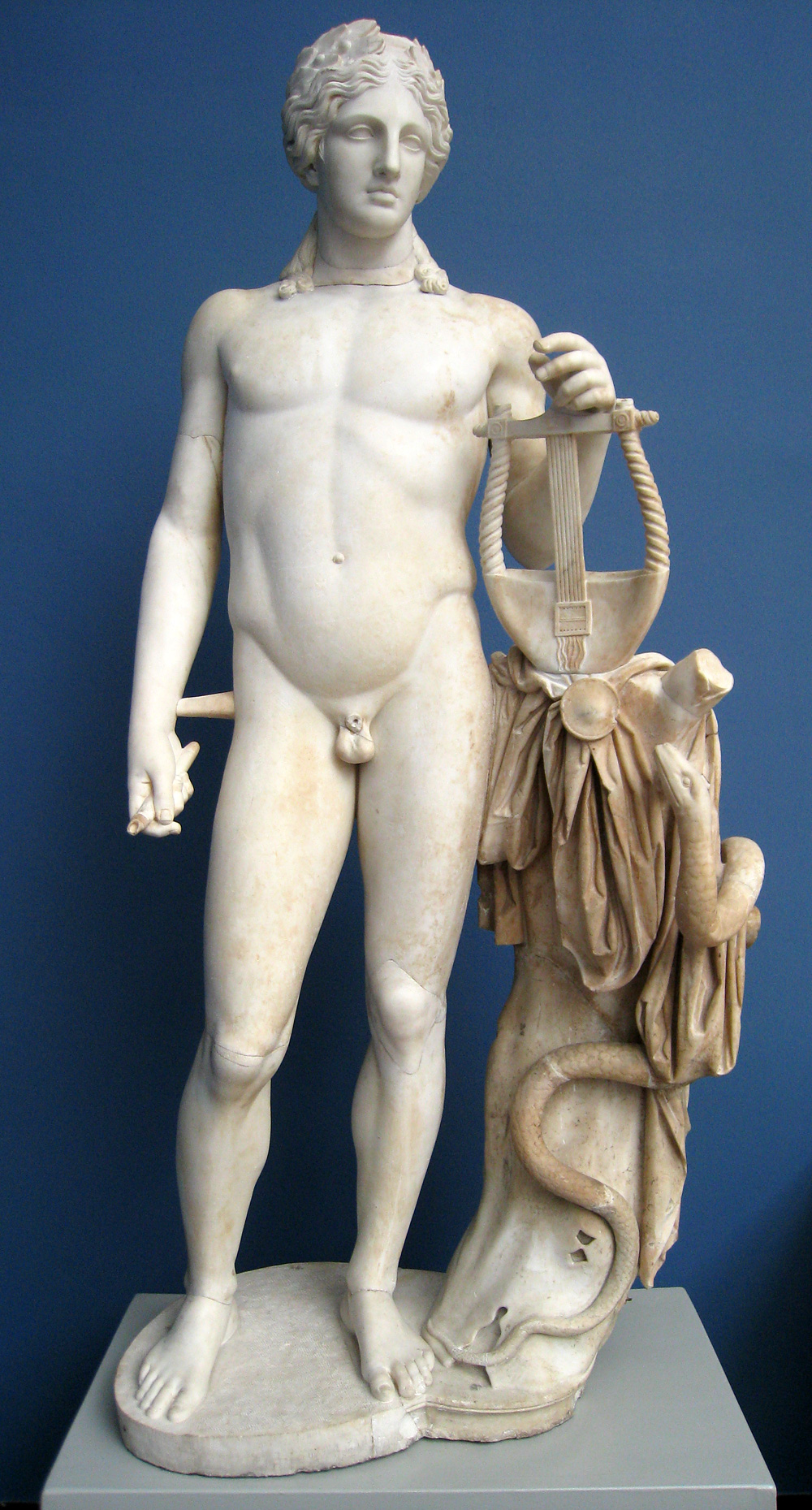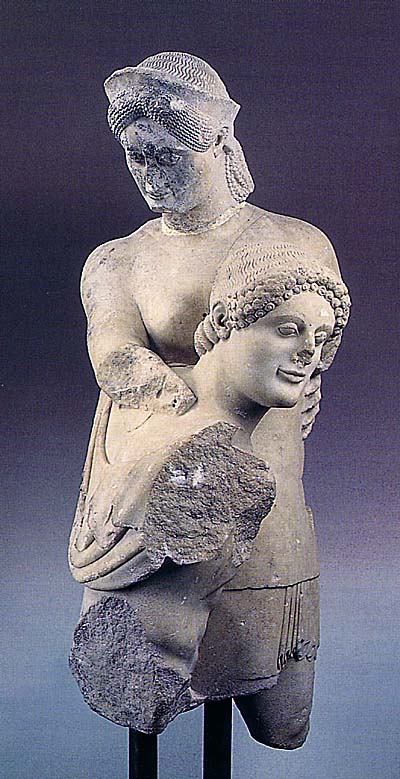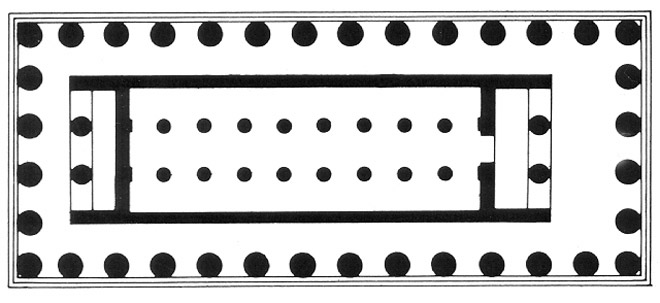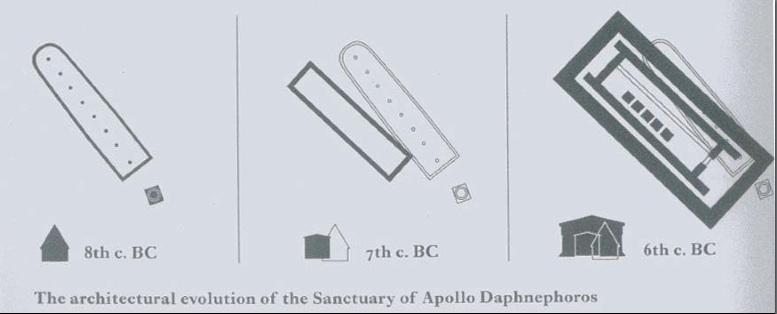Temple of Apollo Daphnephoros at Eretria
Please edit the page properties (see here for instructions) to change the title to the name of the archaeological site you will be writing about, then replace the Italicised instructions below with your entry... If you want to know how to add e.g. additional images, podcasts, etc., please see this page. If copying from word, rather than using CTRL-V, please click the small "paste from word" icon (with a 'w') which neatens up the formatting.
Archaeological Development of the site
The information regarding the Temple of Apollo Daphenephoros in Eretria is limited. There is not even a wikipedia page on it! Eretria is a town in Euboea, Greece which faces the coast of Attica. In the 5th and 6th centuries, it was an important Greek polis and the first mention of it in literature appears to have been in Homer's Iliad, when he mentions it as one the cities who provided ships against the Trojans.
There were at least four temples on this site. The intial structures there were apsidal ones which are dated to the 8th century. After this came a wooden temple which wouldn't have lasted very long! Then the larger stone temple of which the remains are still visible today.
Construction began on the temple in the late sixth century, probably around 520- 490 BC. In 490, the temple was destroyed by a Persian invasion. After this, it was repaired and rebuilt. It was uncovered in 1895 and excavated was completed within days. Several unique features were commented upon by the excavators. In particular, its foundations proved interesting in their type. Usually, temple foundations are solid platforms whereas these were more akin to walls that ran underneath the collonades and the cella walls.
Along with the theatre, this temple is one of the wider known monuments from Eretria. It is a part of the sacred temenos of Apollo which is used as a religious centre and place for worship. The temple is situated north of the agora. According to the Homeric hymn regarding Apollo, it was founded when Apollo was searching for a location for his temple when he stumbled upon the Lelantine Plain.
Eretria itself has a varied history. It began as a naval city in the Geometric period. In 500 BC, Eretria contributed ships to the Ionian Revolt. This resulted in the Persians retaliating in 490 BC which destroyed Eretria and led to many inhabitants being enslaved. Eretria then became an ally of the Delian League and was allied to Athens. It fell under the control of the Macedonians but then was plundered by the Romans in 198 BC. In 87 BC, it was destroyed in the Mithradatic wars and no new settlement was built. It remained swamp land until the 19th century.

Gods/Heroes
Apollo Daphnephoros was the main god to be worshipped at this temple. This epithet was gien to Apollo in reference to the myth which Ovid also wrote of in his Metamorphoses. It begins with Apollo mocking Eros over his poor archery skils. To make him pay, Eros causes Apollo to fall in love with Daphne with the aid of his bow. Daphne is then transformed into a laurel tree.
It is not clear how or why Apollo was worshipped at this site but there is an inscription which describes the temple as the 'place where citizens are to take the oath'. It is also likely that the Homeric hymn on Apollo describing Apollo's search for a place to establish his temple was part of the reason for his being worshipped at Eretria. 
Due to the nearby theatre, it is possible to conclude that this and the temple were part of one religious and civic centre. There are inscriptions stating that Dionysus was worshipped in Eretria and that the temple itself was probably in honour of him.
There is an idea that Artemis was also worshipped here. This comes from the importance of water to the shrine. The altar was located just next to the spring.
Ritual Activity
Sacrifice-
There is a structure which appears to have been an altar due to the build-up of ash and charcoal on the surface of it. There seems to have been a layer of clay on top of it.
Evidence suggests that at least 32 sheep and goats were sacrificed in the Geometric period. This was presumably followed by the ritual meals.
Dedications-
There is a huge amount of pottery shards at the site- 13000 vessels. High - necked vessels are rarer- only 43 were found. This suggests that there was an important function for them in the worship at this temple .Perhaps the rarer vessels were linked to a particular event and were used by priests or priestesses.
Festivals-
There is evidence of cult worship depicted on the fragments of pottery. One shows a cult statue of a female divinity flanked by a worshipper, a person next to the burning altar and a person seated on an animal;
Other-
The phenomenon of security hoarding was in place at Eretria. Here, below the foundations, was found a skyphos with a lid which contained a large number of gold and electrum pieces, weighing about half a kilogram[1].
Rules and Regulations
note here any rules and regulations relating to sanctuary use that have been found inscribed in and around the site.
Other Activities
As stated earlier, along with the temple at this site, there is also a theatre to Dionysus suggesting that within this location, there was a complex for people to visit. It was most likely a social hub, much like the Forum in Rome, where religous, social and financial interests were tied together.
Historical Significance

The architecture on the temple is of particular importance as it is a well preserved example of Archaic sculpture. The pediment sculpture depicting the abduction of Antiope, queen of the Amazons, by Theseus is dated to the Late Archaic period (510-500 BC). The central figure was the goddess Athena surrounded by Amazons. It is thought that the scupting was completed by Antenor who was an Athenian.
Who used the site, and where did they come from?
This temple evolved from the Geometric period through the Archaic, Classical and Hellenistic periods. Eretria was one of the leading Greek cities in establishing cities abroad. Due to it being by the coast, it is likely that this temple performed its function not just for people in the area but also those who were travelling through.
Select Site Bibliography
Insert a bibliography here.
Footnotes
[1] https://cdr.lib.unc.edu/indexablecontent/uuid:7ee25f59-4f5b-4a4f-b96e-b9a846dbb67d
[2] https://www.gtp.gr/LocInfo.asp?infoid=9&code=EGRHEV30EREERE00021&PrimeCode=EGRHEV30EREERE00021&Level=10&PrimeLevel=10&IncludeWide=1&LocId=61013
[3] http://www.unil.ch/files/live//sites/esag/files/shared/images/eretria/Eretria_XIV/Gnomon_2010.pdf
2- If you press "shift + enter" it will insert a line break without any paragraph spacing.
Location
http://vici.org/vici/11027
Please add the location here. Also, search for it on Pelagios (click here) and add a link to "further information" about the place.
You might even want to embed a map to show it within the context of other archaeological sites from vici.org, like below. To find out how to do this, see the further instructions page.
Site Plan


